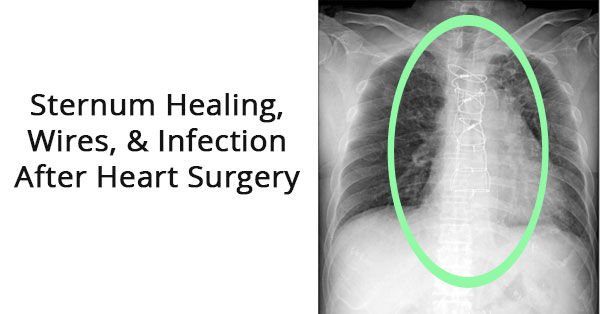“What About Sternum Healing, Wires & Infection After Heart Surgery?” asks Joachim
By Adam Pick on December 12, 2017
At the Heart Valve Summit, I received a great question about sternum healing, wires and infection. Joachim asked me, “Publications have revealed that 50 to 80% of sternal infections are discovered after discharge, and that cardiac patients have the highest readmission rates. Since the sternal wires are the only force holding the sternum together after surgery, why is it that external chest supports are not a standard, adjunctive, and precautionary procedure after surgery?”
To get Joachim an expert opinion, I was very fortunate to sit down with Dr. Steve Bolling, a leading cardiac surgeon from Michigan Medicine in Ann Arbor. Here are the highlights from our chat:
As always… Great advice and information from Dr. Bolling. It was really interesting to learn that the sternum only typically needs about four weeks to heal. So you know, I had open heart valve surgery about 12 years ago. Even today, 12 years later, I can sometimes get a little shoot of pain in my sternum when I’m lifting something in an awkward position.
Many thanks to Joachim for his question and a special thanks to Dr. Steve Bolling for sharing his clinical experience and research with us.
- Jeff Travels 2,000 Miles for a Guaranteed Mitral Valve Repair by Dr. Bolling
- See Dr. Bolling’s Interactive Surgeon Profile
- Discover the Michigan Medicine Heart Valve Microsite
Keep on tickin!
Adam
P.S. I have provided a written transcript below for the hearing impaired members of our community.
Adam Pick: Hi, everybody. It’s Adam with HeartValveSurgery.com. We’re answering your questions live at the Heart Valve Summit. I’m thrilled to be here with Dr. Steve Bolling from Michigan Medicine. He’s a cardiac surgeon. Steve, thanks for being with me.
Dr. Steve Bolling: Adam, thanks for having me.
Adam Pick: As you know, Steve, we’re answering these great questions that came in from our community. This one comes in from Joachim. He writes, “Publications have revealed that 50 to 80% of sternal infections are discovered after discharge, and that cardiac patients have the highest readmission rates. Since the sternal wires are the only force holding the sternum together after surgery, why is it that external chest supports are not a standard, adjunctive, and precautionary procedure after surgery?”

Dr. Steve Bolling: Joachim, that is a really interesting question. First of all, the infection rate from a sternal incision is actually pretty low; it’s less than 1%. In many units it’s far less than that these days. With sternal wires, your sternum should be stable. If you have sternal instability, something has gone wrong. Those sternal wires are actually stronger than your bone and should hold the bone together. It’s just like a broken bone. Yes, we do put a cast on your arm when you break it. The difference is you’re not breathing with your arm.
Remember, Joachim, you have to move your entire chest cavity in and out to breathe, so I don’t want to clamp that chest cavity down. One, you can’t breathe, and two, you’re pneumonia rates are higher. Remember, I want you out of bed and walking, walking, walking immediately after surgery. Your sternal wires really should make that incision stable, and if they’re not, the patient needs to say something and the physicians need to do something.
Adam Pick: Steve, a quick followup. A lot of our patients have been asking about this. The sternum, through a traditional open-heart sternotomy, how long does it take after those wires have been put around the sternum, after they’ve been slammed together, to heal?

Dr. Steve Bolling: That’s an interesting question. The healing of a bone occurs in two ways. The bone cells come in, called blasts, and they just dump a whole bunch of calcium in there. If you’ve ever seen a broken arm, four weeks later it’s completely as strong as it’ll be and it has a huge amount of calcium in there. You’ll think, oh my gosh, where’d that all come from? Then, it takes about eight weeks when a different type of cell, the osteoclasts, come in. They’re the artists; they sort of trim away the bone. Ten to twelve weeks later, it looks perfectly normal. The strength is probably all there at four weeks, but there’s still some tailoring, so the patient may feel something after that. Really, at four weeks it’s pretty much as strong as it’s ever going to be. In fact, patients ask me, oh at four weeks, can I get into a car accident? We say, no. We recommend against car accidents anyway.
Adam Pick: As always, Steve, thanks for your help here at the Heart Valve Summit. I know you’re one of the directors here. Thanks for taking care of so many patients in our community that have come to you and your team. You’ve just done an incredible job. It’s an honor to be here with you.
Steve Bolling: Adam, thanks for having us again.
|
Marianne Peck says on December 12th, 2017 at 10:41 pm |
|
I had metral valve replacement 2 years ago .One year past surgery I developed sternal infection and was started IV antibiotic infusions daily for 7 weeks .I was then started on oral antibiotics daily .The Dr,s fear a reaccurance of the infection because of the wires in my sternum. I worry about antibiotic resistance and would like to get off the antibiotics.Dr,s disagree with this. My question is :Is it medically possible to remove the wires? |
 |
|
Adam says on December 13th, 2017 at 3:26 pm |
|
Hi Marianne! Sorry to hear all that you’ve been through. To answer your question… I understand that the wires can be removed. I have spoken to a few patients that have had this done. Here’s some more information that might be helpful for you – https://www.heart-valve-surgery.com/heart-surgery-blog/2011/08/23/pain-chest-sternum-wires-lishan-aklog/. |
 |
|
Earl Meech says on December 14th, 2017 at 12:47 pm |
|
I had aortic valve replaces 2 1/2 years ago at the age of 84. All went very well. My niece is a doctor and she thought that my surgeon had don a great job. The scar is hardly visible. My cardiologist was showing an assistant my chest and said the wires can be felt. With my permission, he felt around and could not find any indication of wires. Dr. Wm. Davis of Methodist Hospital in San Antonio, TX was my surgeon and I recovered in record time. |
 |
|
Joachim Hjorth Hansen says on December 21st, 2017 at 6:13 am |
|
Thank you so much for asking my question to Dr. Bolling. And thanks to Dr. Bolling for his answer. I’ve been trying to post a more detailed comment to this discussion but it gets removed each time. Is there a reason for this? Could you please check? Thank you. |
 |










